AFTER more than a year, the government has given the green light for marine conservationists to treat corals infected with stony coral tissue loss disease as well as to study and better understand its spread.
Stony Coral Tissue Loss Disease (SCTLD) is the deadly and relentless plague ravaging the country’s reefs like a forest fire.
Earlier this month, conservationists sounded the alarm at a press conference at The Bahamas National Trust about the issue.
This breaking news is being celebrated after backlogged research permits had sidelined action by the country’s own world-renowned scientific experts and local environmental groups for over a year, a press release from conservationists said.
“It’s like Christmas came early – we’re so pleased the government is partnering with us on this life-saving work,” said Dr Craig Dahlgren, executive director of Perry Institute for Marine Science (PIMS), a Bahamas-based research non-profit on the frontlines of the Caribbean coral crisis. “This country made history when it established the world’s first land and sea park more than half a century ago. Together, we’re ready to make history again and tackle SCTLD with everything we’ve got.”
According to the press release, “science across the country came to a halt” after the new Biological Resources and Traditional Knowledge Act was passed in 2021.
“Government adopted the new legal framework to capture value from commercial innovation and ensure research involving the country’s natural resources benefits Bahamians first and foremost,” the release noted. “But the consequent implementation of the Act has, until now, been fraught with political turmoil and bureaucratic peril. This created a quagmire for local non-profits, mom and pop businesses and both national and international environmental organisations hoping to do economically and environmentally critical and time-sensitive science and conservation work.
“But now there are signs of hope for transitional permits while the Cabinet has undertaken to revise the law to aim at its original intent — to capture monetary value through patents where commercially possible while simultaneously promoting, not blocking, conservation-oriented, non-profit scientific research and ecosystem restoration.”
Eric Carey, BNT executive director, said the groups hope the permits scientists received last week “are a harbinger of much more science and conservation approvals to come” and reiterates the government’s leading role in all environmental and economic issues.
With permits in hand, a coalition of environmental non-profits are set to begin broad-sweeping SCTLD monitoring, evaluation, and treatment across The Bahamas. Scientists now hope the government will soon allow samples to be sent to state-of-the-art international analytical laboratories which is a key tool in speeding humanity’s ability to stop the spread.
Alongside government staff, Perry Institute marine biologists will work as fast as possible to heal infected corals using an antibiotic paste and prevent the extinction of coral species from The Bahamas. Given the severity of the crisis at hand, the Perry Institute has also co-led the establishment of a living coral “gene bank” to preserve Bahamian corals in Atlantis’ aquarium. To date, the Perry Institute has secured sustainable project funding upwards of $1 million USD with more to come.
“The gene bank is a groundbreaking opportunity for us to save corals from SCTLD and for The Bahamas to fully establish itself as the global leader in coral science and restoration,” Dr Dahlgren added. “We’re excited to work closely with the government, already-committed philanthropic funding, and Atlantis so see this project through.”
SCTLD was first discovered off the coast of Miami in 2014. Five years later, Dr Dahlgren’s team at the Perry Institute confirmed its presence off the southern coast of Grand Bahama. The disease, which is so fatal it can wipe out a 200-year-old coral in less than two months, has already caused far-reaching and irreversible damage to Bahamian coral reefs – the lifeblood of the nation’s blue economy.
Coral reefs are the nation’s chief tourism and fisheries asset, valued at up to USD $135 million per square kilometre. They also protect coastlines from storm surges and erosion, reducing wave energy by about 97 percent, conservationists say.
In the three years since SCTLD first spread to The Bahamas, it has wiped out corals over more than 100 square miles of reef across the country: nearly 50,000 football fields worth of dead coral. The highly contagious disease has been identified offshore of at least six major Bahamian islands to date and scientists are linking its spread to ballast water from commercial shipping vessels and cross-contamination by recreational and commercial boating.





Comments
DWW 2 years, 1 month ago
good work
Sign in to comment
Or login with:
OpenID